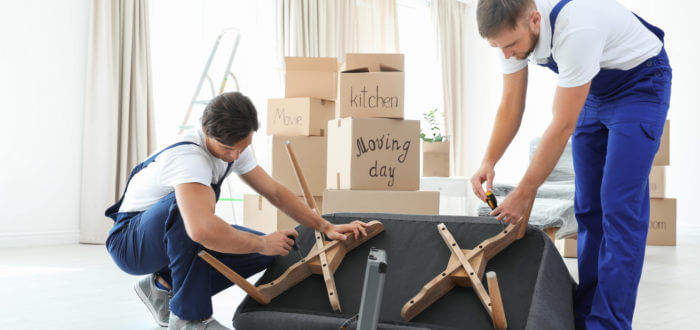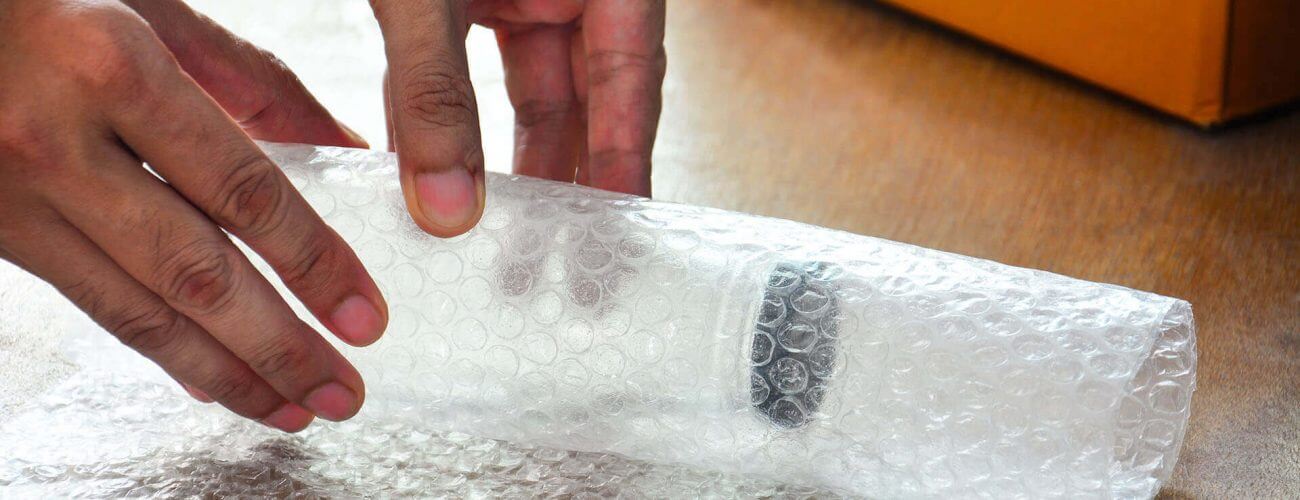

The Best Tips on How to Pack Fragile Items When Moving
Posted in How-to,Moving Tips & Tricks on February 18, 2021
Every home has some precious pieces, dinner sets, dishes, or beautiful figurines. So, knowing how to pack fragile items is a must if you want to retain your valuable belongings in the new place. This process demands focus and attention to detail, so buckle up because we’re about to break down how to do this.
Some fragile objects, such as authentic Chinese porcelain, can last up to a thousand years, or at least that’s what the Chinese manufacturers used to say about their craft. Perhaps you didn’t really plan on preserving your breakables for centuries on end, but getting to your new home without any damage is what everyone wants. So, make sure you follow our expert guide if you don’t want your bowls or vases to become a loving memory.
Packaging Fragile Items and Moving Fragile Items Requires Thorough Planning
As soon as you finish your where should I move quiz or determine your reasons to move cross country in another way, it’s time to start planning. Even if the date seems to be far away, breakables are quite tricky because they can only be packed in certain materials, and the procedure is not the same for different categories. So, don’t wait for the eleventh hour to learn how to pack fragile items for moving because that can diminish your chances of succeeding. Start as soon as you can, and you’ll enjoy the benefits later on.

What to Use to Pack Fragile Items and How to Choose the Right Cardboard Box?
Packaging fragile items requires the right materials and supplies because not being attentive about these can lead to terrible results. So, boxes and packing supplies usually cannot be changed with DIY alternatives for the simple reason that you risk breaking some of your valuables if you go for a yet untested option. That being said, here are the things you should search for:
- Packing paper for moving – In abundance, actually. This is a task in which there’s never too much paper, so make sure you obtain large quantities.
- Bubble wrap – A good candidate for the title of the best packing material for fragile items, it can help you with almost any piece.
- Pieces of cardboard – You can use them to your advantage in various ways.
Use a Sturdy Cardboard Box for Packing as the Best Packing Material for Fragile Items
You should dedicate a part of your organization and moving binder to getting the right box for every fragile item you own. In order to know what these are, you must create a household inventory list and single out the breakable pieces. Then, you’re ready to hunt for containers.
If you’re looking into how to pack glasses for moving long-distance, or plates for that matter, you’ll see that in that case, there’s a possibility of placing more than one piece inside. In most other cases, that is not possible, so bear that in mind.
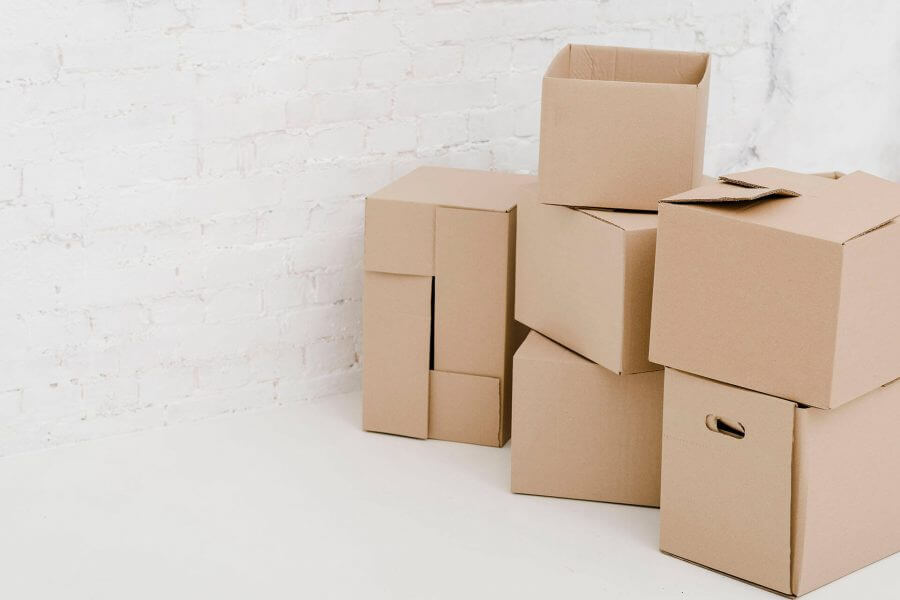
How to Wrap Fragile Items?
If feeling remorse is not on your things to do after moving checklist, make sure you wrap your belongings with care. Wrapping is just a small part of the entire process, but if you mess up there, you might ruin it all. And in case of any unexpected problems or moving scams, the insurance company will usually pay your indemnification only if you prepared the item for transport and shipping properly. Take a look at the following video if you’d like to learn more about this skill.
How to Pack Fragile Items for Moving Across the Country? Getting Down to Packing
There’s a logic that you can apply for almost all of your belongings in this category. And if you want to achieve the desired result, take your time and do each step with a clear mind. Grab your moving essentials because these are the steps.
Step 1 – How Do You Wrap a Fragile Object for Cross-Country Moving?
Cover your item entirely depending on the category. And remember to seal it with enough tape. Then, you’re ready to check if there’s any bit sticking out. Your chances are as big as the chances of your most vulnerable parts making it through the relocation, so keep that in mind. If it’s all fine, you can move on.
Step 2 – Take a Container That Is the Right Size and Grants You Enough Protection
As discussed above, you need a container large enough to contain your item. Double-wall boxes are a better choice than single wall here because they are more resilient to all they have to take during the cross-country moving. And if you’re moving in winter, you’ll be wanting even better protection, so do research on the best options.
Step 3 – Fill the Void
Regardless of what material you opt for, ensure you fill your box with padding. It can be wadded paper, foam, or peanuts. But you should first fill the container to half and then put your wrapped item in the center and ensure it is not close to the edges. After that fill all the remaining space with protective material. The more loose space you leave, the more chance your item will be thrown around and that is something you want to avoid.
Step 4 – Seal the Package Shut So the Cross Country Movers Can Carry It With Ease
When you’ve finished the preparation phase, ensure you seal your package with tape. If it is a heavy item, you can also make an X with tape to reinforce the bottom. The tape should be flat or else it might lose its protective value.
Step 5 – Label Which Side Is Up for Long-Distance Moving
After you have written fragile across your carrier, ensure you signal clearly what side is up so that you or cross-country movers know exactly how to handle it.
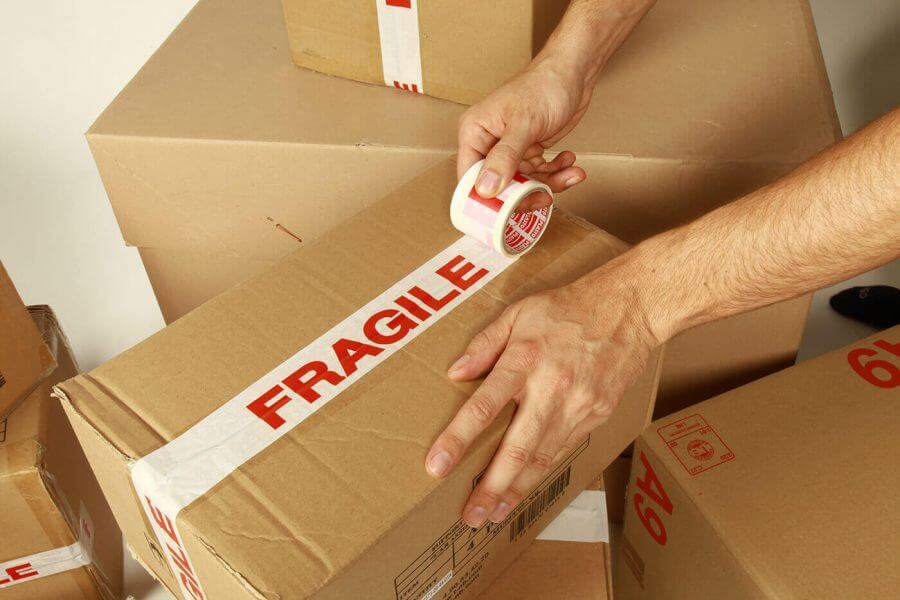
Packing Tricky Objects Before the Cross-Country Movers Arrive
Working out the question of how much do movers cost and letting them take the upper hand with this is the easiest route, especially if you’re moving to another state alone. Still, if you want to handle your possessions on your own, it might help to know what to do about particular categories.
How to Prepare China for Moving Cross-Country?
China is in some people’s families for a very long time and usually represents a memory. So, whether you’re moving for love, or taking memories of it with you, you want to give it all you’ve got to ensure your China is fully protected. And this is how you deal with a beautiful dinner set:
- Take care of all the components separately,
- Plates should be wrapped in stacks consisting of at least three or four pieces,
- Bowls go one by one, especially in this case when they’re all valuable,
- Glasses can be prepared following the standard rules.
How Do You Pack Fragile Figurines?
Many collectors or art fans like figurines whose shape and volume can range a lot. Still, they’re all pretty frail, so you might want to do all you can to ensure they live through the transition. The following procedure will set you up for success:
- Close any openings or cracks,
- Wrap the entire figurine and finish it off by wrapping the bundle in bubble wrap,
- Get a sturdy enough container and repeat the procedure.
How to Deal With Glasses?
If you know how to pack dishes for moving, you’ve been through this already. And if not, now is the right time. If you want to pack a mug or a glass, it should be placed in the corner of your paper. Ensure you’ve got two sheets and ensure you tuck it in the glass as you go. Position a glass six inches from the center and then roll over it. If it’s got a stem, fill the inside with crumpled scraps and protect the stem before you roll.
How to Deal With a Vase?
You don’t want your precious antique pottery to take your mind off searching for answers to pressing questions, such as how to get a job before you move. And vases are special and require extra effort. Don’t forget to put foam around the body and then wrap it three to four times. Close the bottom and upper part with some more bubble wrap and tape and apply the same method as for other boxes when you finish it off.
What About Oddly-Shaped Objects?
If your object creates problems due to its odd shape, there’s a solution. Ensure you wrap it in a padding material, put cardboard as a base and another thick strip of cardboard as a roof layer. Connect the two and seal it with tape. Then bundle it all again.
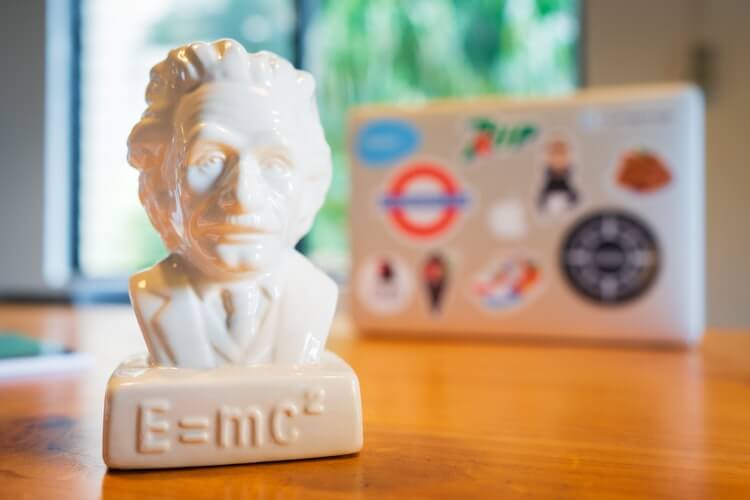
How Do I Protect My Fragile Packages? – Expert Tips
Now that you’ve mastered the basics, you’re ready for moving hacks and all the expert tips. Considering all we already explained, try to remember this too.
Don’t Overpack the Box
It’s not the same as learning how to pack clothes for moving. In this case, you must ensure you leave enough space between the objects. All the remaining space should be filled with wadded paper or other cushioning because you want to reduce any chance that your objects will move during the relocation.
What Not to Use to Pack?
Regardless of your moving budget, there are some materials that you should avoid because they can create problems:
- Flimsy boxes – If a container is not sturdy enough, you’ll do best to avoid it.
- Newspaper – The method can lead to smudging, and you’ll be safest if you opt for other materials.
- Towels – They are impossible to tape and thus highly unreliable.
- Bubbles are actually not a good idea if your item is heavy because they can burst.
Label Is a Must for Long-Distance Moving
If you’re wondering how to pack a moving truck, this one is something you should by no means skip. You need to label what side is up and that the contents are fragile by all means.
Consider Dishboxes if You Don’t Want Long Distance Movers to Handle Cardboard
These are quite resistant and for that reason, they can endure long distances. Investing in them for this purpose is quite worth it since they can help you avoid double packaging.
Packing Fragile Items for Moving Is Made Easier With Celldividers
These can be made out of cardboard and they come in handy if you want to create space to put more objects in the box. Just ensure you don’t abuse this and finish packing more than you intended.
How to Package Fragile Items for Shipping Through Cross-Country Moving Services? Stack Vertically
This is a rule you should be very careful about. Though things may stand horizontally in a cupboard, they must be packed vertically for shipping or transportation to avoid any potential damage.
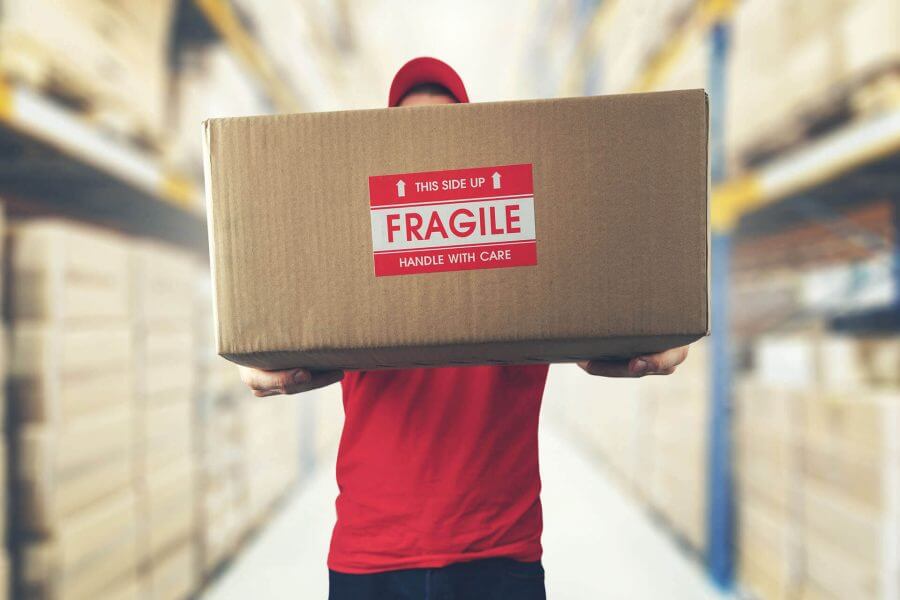
Professional Long-Distance Movers Know How to Pack Fragile Items or Prepare Them for Storage
A reputable company will ensure to answer all your questions such as how to package fragile items for shipping or lend you a hand with top-rated cross-country moving services such as packing services that come with boxes and moving supplies, car shipping, and storage services. Perhaps you’ll do your best to contact and rely on professionals and ensure the safety of your breakables that way.
FAQ
What Are the Best Materials to Use for Packing Fragile Items?
The best materials for packing fragile items are those that provide cushioning and shock absorption to protect the items during transport. Bubble wrap, foam peanuts, and packing paper are commonly used materials for wrapping fragile items. Bubble wrap has air-filled bubbles that provide cushioning, while foam peanuts are lightweight and can fill empty spaces in the package. Packing paper, on the other hand, is a simple but effective way to wrap fragile items and prevent them from rubbing against each other.
How Can I Prevent Fragile Items From Breaking During Transportation?
Firstly, wrap each fragile item individually with bubble wrap or packing paper, and make sure there is enough cushioning to absorb shocks. Then, fill any empty spaces in the package with packing peanuts or other void fillers to prevent movement during transport. Additionally, using sturdy boxes and securing them with packing tape can help prevent damage to the items. It’s also important to label the package as fragile and ensure that it’s handled with care during transport.
How Can I Pack Fragile Items Such as Glassware, China, and Porcelain?
Firstly, wrap each item individually with bubble wrap or packing paper, making sure to cover all sides and corners. For added protection, you can also use foam sheets or foam pouches to wrap the items. Then, place the wrapped items in a sturdy box, making sure to fill any empty spaces with packing peanuts or other void fillers. Ensure that the items fit snugly in the box and do not move around during transport. Finally, label the box as fragile and mark it as “This Side Up” to ensure that it’s handled with care.
What Is the Best Way to Pack Fragile Electronic Devices Such as TVs and Computers?
Firstly, remove any detachable parts such as cords, batteries, and controllers, and pack them separately. Then, wrap the device in bubble wrap, making sure to cover all sides and corners. For added protection, you can also use foam sheets or foam pouches to wrap the device. Place the wrapped device in a sturdy box, making sure to fill any empty spaces with packing peanuts or other void fillers. Additionally, label the box as fragile and mark it as “This Side Up” to ensure that it’s handled with care. It’s also important to use boxes that are designed for electronics, as they often have additional protection features such as reinforced corners and foam inserts.
How Do I Pack Fragile Artwork, Mirrors, and Picture Frames?
To start, make sure you have enough bubble wrap to cover each item completely. Then use packing tape to firmly affix the bubble wrap to the picture frame or mirror for extra security. When you’re finished wrapping each item individually, place them in a sturdy box lined with packing paper or newspaper to further cushion them from any bumps or vibrations along the way. Lastly, don’t forget to label your package as “Fragile” so that handlers will take extra care!
How Can I Pack Fragile Items With Irregular Shapes or Sizes?
Fill your box with packing peanuts, newspaper, or other filler until the item is tightly cushioned without shifting around in the box. To secure the item further, use packing tape to affix it securely within the box. For an extra layer of protection, use bubble wrap and a few pieces of cardboard to further cushion any nooks and crannies that could get scuffed during transport. Lastly, label your package as “Fragile” to ensure handlers take special care when handling it.
Is It Necessary to Purchase Special Packing Supplies for Fragile Items?
While you can technically pack fragile items without special packing supplies, it’s not recommended. Bubble wrap and packing peanuts provide extra cushioning to prevent damage during transport. Packing tape also helps to secure items within the box so they don’t shift around and become damaged. And of course, don’t forget to label your package as “Fragile”!
How Do I Label Fragile Items to Ensure They Are Handled With Care During the Move?
Labeling your fragile items correctly is the best way to ensure they are handled with care during the move. Start by writing “Fragile” clearly in a permanent marker on all sides of the box. Additionally, you can use arrows or other symbols to indicate which direction is up and make sure that the box is not turned upside down or handled roughly while being moved. Finally, if you need extra protection for particularly vulnerable items, consider placing a “Handle With Care” sticker over the existing label.
Should I Pack Fragile Items Separately From Other Items?
Whenever possible, it’s best to pack fragile items separately from other items. Not only is this safer for fragile items, but it will also help keep them from getting mixed up with other items and becoming damaged. Fragile items should be packed in their own boxes and cushioned with packing material such as bubble wrap. If you must combine these items with others in the same box, make sure to label that box as “Fragile” or “Handle with care” and indicate which way is up so that it can be handled safely during transport.
How Can I Pack Fragile Items in a Way That Saves Space in the Moving Truck or Storage Unit?
To save space when packing fragile items, use smaller boxes or storage containers whenever possible. If you have lightweight, large items like comforters and pillows, consider folding and rolling them to fit into suitcases or larger bins. Use bubble wrap, foam peanuts, cushioning blankets, or other wrappings to fill extra space in the box or container and keep the items from shifting during transit.
What Should I Do if I Don’t Have Enough Packing Materials for All of My Fragile Items?
If you don’t have enough packing materials for all of your fragile items, try using household items such as towels or blankets as extra padding. Newspaper can also work in a pinch, but it can be messy and may not provide the same level of protection. If possible, get some additional bubble wrap and foam peanuts for extra cushioning. You could also ask friends and family if they have any packing materials that you could borrow. Finally, consider purchasing or renting boxes specifically designed for fragile items – these can often provide more secure protection than other options.
How Can I Ensure That My Fragile Items Are Protected During the Loading and Unloading Process?
To ensure that your fragile items are protected during the loading and unloading process, start by using sturdy boxes and containers that can handle the weight of your items. Pack each box or container securely with bubble wrap, foam peanuts, or cushioning blankets to prevent any shifting or jostling while in transit. When loading the truck or storage unit, be sure to place the boxes labeled “Fragile” at the top and keep them separate from other items. If someone else is helping you move, remind them to handle all fragile items with care. Lastly, make sure to check all of your boxes for any damage upon unloading.
What Should I Do if a Fragile Item Breaks During the Move?
If a fragile item breaks during the move, be sure to assess the damage and determine if it can be fixed before attempting any repairs. If the item cannot be repaired, you may wish to consider taking photos for insurance purposes. Additionally, check your moving or storage insurance policies for coverage of broken items as some policies offer reimbursement for damaged goods. Finally, if possible, try to find a replacement, and be sure to ask friends and family if they have any similar items they are willing to part with.
How Can I Ensure That My Fragile Items Are Covered by Insurance During the Move?
To ensure that your fragile items are covered by insurance during the move, make sure to contact your moving or storage company ahead of time and review their policies. You may find that some companies offer insurance coverage for certain fragile items such as furniture, artwork, and electronics. Be sure to inquire about the type of coverage they offer, the amount and duration of coverage as well as any deductibles or other fees required. Additionally, check with your home insurance provider to see if they provide additional coverage or can add a rider to your policy for fragile items that are being moved.
How Far in Advance Should I Start Packing My Fragile Items Before the Move?
To ensure that your fragile items are packed properly before the move, you should start packing them at least one to two weeks in advance. This will give you enough time to properly wrap and secure your items so that they are secure during transport. It is also important to make sure you have all the necessary supplies on hand such as bubble wrap, packing peanuts, foam padding, moving blankets, and sturdy boxes. Additionally, label each box clearly with its contents so that everything can be found easily upon arrival at your new home.

